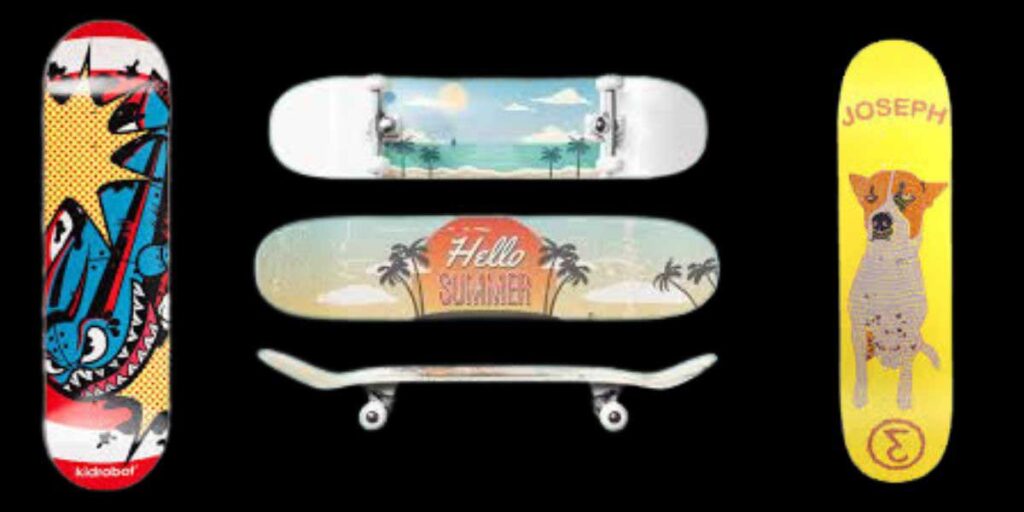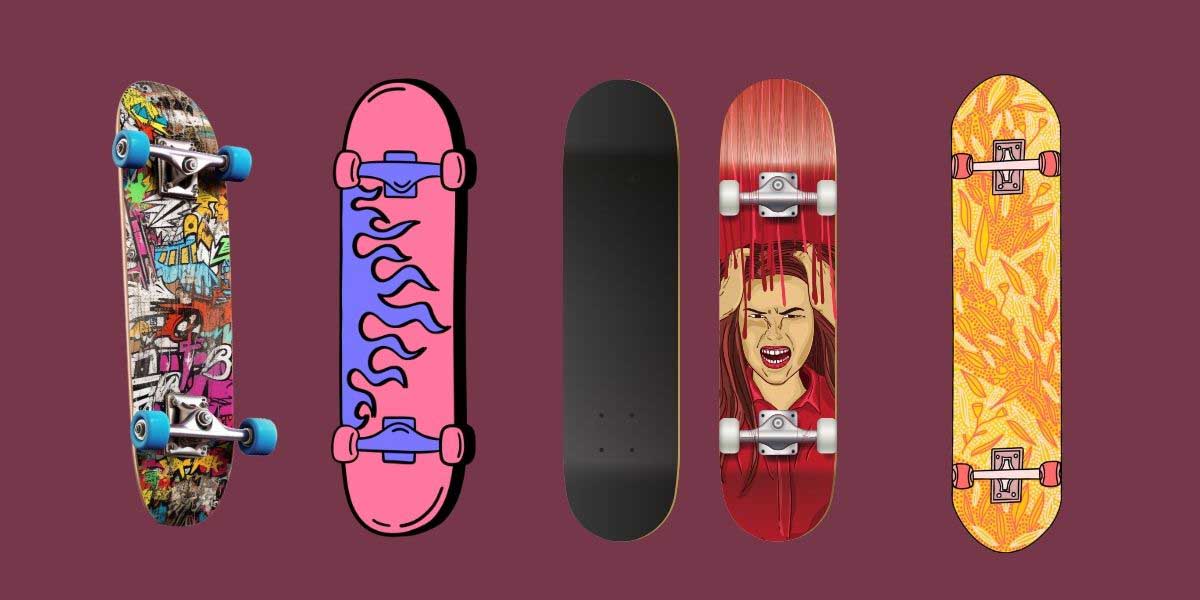Choosing the right skateboard deck is crucial for any skateboarder. Whether you’re just starting or have been skating for years. Your deck affects how your skateboard performs, how comfortable you feel, and how much fun you have.
To find a good skateboard deck, focus on its material, shape, size, and brand. Ensure it fits your skating style and budget.
In this content, we’ll walk you through everything you need to know to choose a skateboard deck that’s perfect for you. This guide on how to choose a good skateboard deck will help you make an informed decision. Let’s get started!
Understanding Skateboard Deck Basics
What is a Skateboard Deck?
A skateboard deck is the part of the skateboard that you stand on. It’s flat and made from various materials. It is also designed to provide a stable platform for performing tricks and riding.
Key Components of a Skateboard Deck:
- Shape: Influences how the skateboard handles.
- Material: Affects durability and ride quality.
- Size: Impacts comfort and control.
The deck is just one part of the skateboard. But it’s essential for determining how the board performs. A well-chosen deck can make your skating more enjoyable.
Types of Skateboard Decks

Skateboard decks come in different types, each suited for specific styles of skating:
- Street Decks: These are the most common type, typically flat and versatile. Ideal for tricks and street skating.
- Cruiser Decks: Smaller and often have unique shapes. Designed for a smooth ride on various surfaces, perfect for commuting or casual rides.
- Vert Decks: Wider with a steep concave, these are designed for ramp and vertical skating, offering stability at high speeds.
- Longboards: These are longer decks made for cruising, downhill racing, or long-distance rides. They provide a different riding experience compared to traditional skateboards.
Choosing the right type of deck depends on your primary style of skating and what feels comfortable to you.
Key Factors to Consider When Choosing a Skateboard Deck
Deck Material
The material of the skateboard deck significantly influences its performance and durability:
- Maple Wood: Most skateboards are made from maple wood. It’s durable and provides a traditional, reliable feel. Maple decks are known for their strength and are the go-to choice for most skateboarders.
- Bamboo: Bamboo decks are lighter and offer more flex. They provide a smoother ride and are eco-friendly. However, they might not be as durable as maple decks.
- Plastic: Plastic decks are often used for cruiser boards. They are durable and can withstand various weather conditions. But it might not offer the same performance for tricks.
Tip: Maple wood is a solid choice for beginners and experienced skaters alike due to its balance of durability and performance. If you prefer a lighter board or are interested in eco-friendly options, consider bamboo.
Deck Shape
The shape of the deck affects how the skateboard handles and feels:
- Kicktail: This shape features an upward curve at the end. It’s allowing for easier tricks and better maneuverability. It’s great for street skating and performing tricks.
- Popsicle Shape: This is the most common shape for street skating. It’s symmetrical and ideal for flip tricks and technical maneuvers.
- Cruiser Shape: Typically features a more relaxed design for cruising and carving. These boards often have a wider nose and tail for a more comfortable ride.
Tip: Choose a shape that suits your primary style of skating. If you’re focused on tricks, a kicktail or popsicle shape will be beneficial. For cruising, a cruiser shape is ideal.
Deck Size
The size of your skateboard deck impacts comfort and control:
- Width: Skateboard decks typically range from 7.5-8.5 inches in width. Wider decks (8.0 inches and up) provide more stability and are ideal for street skating and larger tricks. Narrow decks (7.5 inches) offer better maneuverability for technical tricks.
- Length: The length of the deck affects stability and maneuverability. Longer decks offer more stability and are great for cruising and downhill riding. On the other hand, shorter decks are easier to maneuver and better for tricks.
Tip: For street skating, a deck width of 7.75 to 8.0 inches is common. If you’re into cruising or need more stability, go for a wider deck.
Concave and Flex
The concave and flex of the deck impact how it feels and performs:
- Concave: The concave shape is the curve of the deck from side to side. A deeper concave provides better grip and control, especially for tricks. Shallow concaves are more comfortable for cruising and casual riding.
- Flex: Flex refers to how much the deck bends under pressure. More flex can be comfortable for cruising and absorbing shocks. On the other hand, a stiffer deck provides better control and responsiveness for tricks.
Tip: Test different concave and flex options to see what feels best for your skateboarding style. A deeper concave and stiffer deck might be preferable for tricks, while a more flexible deck is suited for cruising.
Skateboard Deck Specifications
Width
The width of your skateboard deck affects how stable and comfortable your ride will be:
- Narrow Decks (7.5 to 7.75 inches): These decks are better for technical tricks and street skating. They are lighter and easier to maneuver.
- Medium Decks (7.75 to 8.0 inches): These provide a good balance between stability and trick performance. They are versatile for various styles of skating.
- Wide Decks (8.0 inches and up): These decks offer more stability and are better for street skating and performing larger tricks. They are also more comfortable for skateboarders with larger feet.
Tip: Choose a width that fits your shoe size. It also provides the level of stability and control you need for your skating style.
Length
The length of the deck affects how it feels and handles:
- Short Decks: These are more maneuverable and suitable for street skating and tricks. They offer quicker responses and easier flips.
- Long Decks: Provide more stability and comfort for cruising and downhill riding. They offer a smoother ride and better control at high speeds.
Tip: A medium-length deck is versatile and works well for general use. If you have a specific skating style, choose a length that matches your needs.
Graphics and Design
While the graphics on a skateboard deck are mainly about personal style, they can also impact your choice:
- Simple Designs: Easier to clean and maintain. They also tend to be less distracting and more classic.
- Bold Graphics: Reflect your personality and make your board stand out. However, they might wear out faster with heavy use.
Tip: Choose a design that you like but also consider how it might affect the board’s performance and maintenance.

Brand Reputation and Reviews
Before buying a skateboard deck, it’s helpful to look at reviews and ratings:
- User Reviews: Provide real-life insights into the performance and durability of the deck. Look for common feedback from other skaters.
- Professional Reviews: Offer expert opinions and detailed assessments of the deck’s features and performance.
Read multiple reviews from different sources to get a well-rounded view of the deck’s quality and performance.
Budget Considerations
Price Range
Skateboard decks come in various price ranges, reflecting their quality and features:
- Budget Decks ($30-$40): Suitable for beginners or casual skaters. These decks are often less durable but can be a good starting point.
- Mid-Range Decks ($40-$60): Offer better quality and performance. They are a good choice for intermediate skaters looking for durability and comfort.
- High-End Decks ($60+): Made from premium materials with advanced features. These decks are durable and perform well. This makes them ideal for serious skaters.
Consider your budget and how often you skate. Investing in a higher-quality deck can be worth it if you skate frequently.
Value for Money
To get the best value for your money:
- Check Material: Higher-quality materials often last longer and provide better performance. Look for decks made from durable wood or high-quality composite materials.
- Consider Features: Features like better graphics, advanced concave shapes, or special flex options can justify a higher price.
Balance cost with quality. A more expensive deck may offer better performance and durability. Additionally, it is a better investment in the long run.
Where to Buy Skateboard Decks
Local Skate Shops
Buying from a local skate shop has several advantages:
- Personal Advice: You can get recommendations from experienced staff who understand skateboarding needs.
- Immediate Purchase: You don’t have to wait for shipping, and you can inspect the deck in person.
Support local businesses if you can. They often provide valuable advice and a personal touch that online stores might lack.
Online Retailers
Major online stores offer convenience and a wide selection:
- Amazon: Provides a vast range of skateboard decks with user reviews and competitive prices.
- Zumiez: Specializes in skateboarding gear and offers a good range of decks with detailed product descriptions.
Compare prices and check return policies when buying online. Make sure you’re purchasing from a reputable seller.
Second-Hand Options
Buying used decks can be a cost-effective option:
- Cost-Effective: Used decks are often cheaper and can be a good deal if they’re in good condition.
- Find Rare Boards: Sometimes you can find unique or vintage decks that are no longer available.
Inspect used decks carefully for signs of wear and damage before buying. Ensure they are still in good shape and suitable for your needs.
How to Test a Skateboard Deck
Physical Inspection
When buying a skateboard deck, especially in-store, perform a physical inspection:
- Construction: Check for any defects or issues with the deck’s construction. Look for cracks, warps, or other damage.
- Graphics: Ensure the graphics are applied well and are not likely to peel off easily.
Handling the deck in person allows you to assess its quality and feel before purchasing.
Testing for Comfort
To test how the deck feels:
- Stand on It: Stand on the deck to see how it feels under your feet. Check if it provides the right amount of grip and comfort.
- Flex and Concave: Apply pressure to test the deck’s flex and concave. Ensure it matches your skating style and preferences.
A deck should feel comfortable and responsive. Take your time to find one that suits your riding style.
Maintenance and Care for Skateboard Decks
Proper Care Tips
To keep your skateboard deck in good condition:
- Regular Cleaning: Clean your deck regularly to remove dirt and debris. This helps maintain its performance and appearance.
- Avoid Moisture: Try to keep your deck dry and avoid skating in wet conditions to prevent warping.
Use a deck protector to keep the graphics looking fresh and to protect the deck from damage.
Signs of Wear and When to Replace
Watch for these signs that indicate it’s time to replace your deck:
- Cracks or Splits: If you notice cracks or splits, it’s time to get a new deck. These can affect performance and safety.
- Loss of Grip: When the grip tape wears out or becomes ineffective, it’s time for a replacement.
Regularly check your deck for signs of wear and replace it when necessary to ensure safety and performance.
Conclusion
Selecting the right skateboard deck involves looking at a few key factors: the material, shape, size, and brand. By understanding these elements, you’ll be able to choose a deck that fits your skating style and needs perfectly.
Take your time to research and test different options. Your perfect skateboard deck is out there, and with the right information, you’ll find it! Have questions or want to share your favorite deck? Drop a comment below or connect with us on social media. For more skateboarding tips and updates, subscribe to our blog! This guide on how to choose a good skateboard deck is just the beginning of your journey to the perfect ride!

